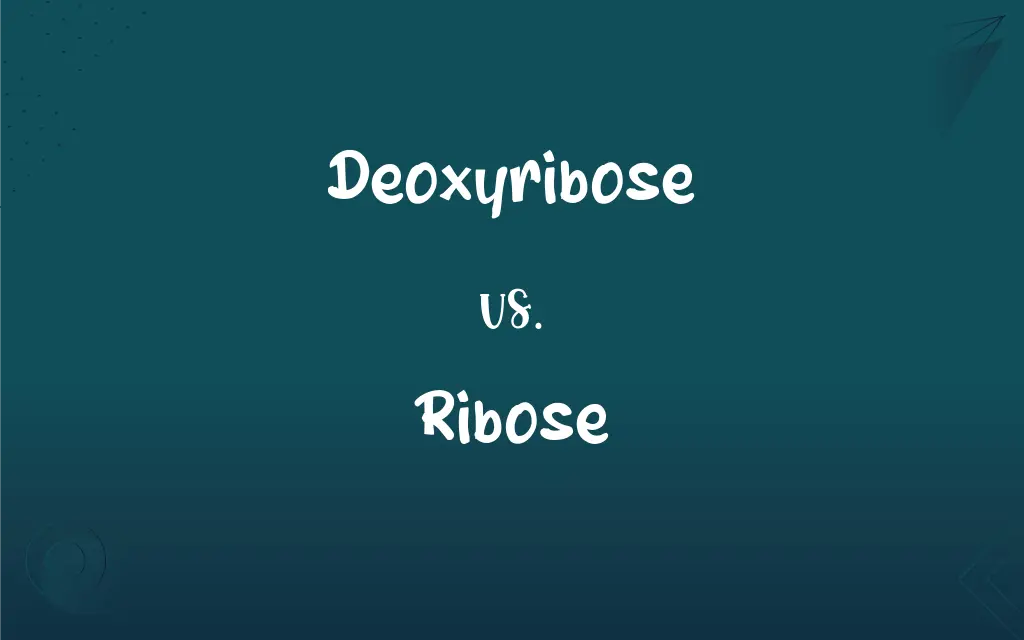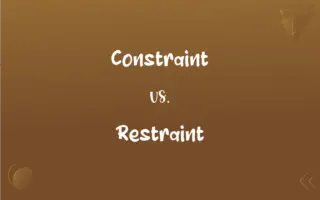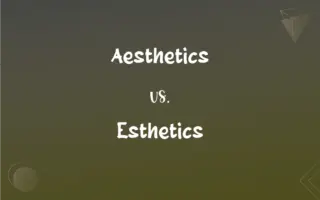Deoxyribose vs. Ribose: What's the Difference?
Edited by Aimie Carlson || By Harlon Moss || Updated on October 30, 2023
Deoxyribose lacks an oxygen atom present in ribose, with both being five-carbon sugars. While deoxyribose is found in DNA, ribose is a component of RNA.

Key Differences
Deoxyribose and ribose are both pentose sugars, which means they each consist of five carbon atoms. The primary distinction between these two sugars lies in their molecular structures. Deoxyribose, as its name suggests, is a "deoxy" form of ribose, meaning it lacks one oxygen atom that ribose possesses. This difference might seem minute, but it has a profound impact on their respective functions within the cell.
Ribose plays a crucial role in the structure of RNA (ribonucleic acid). RNA is responsible for protein synthesis and acts as a messenger carrying instructions from DNA for controlling the synthesis of proteins. Given that ribose is a component of RNA, it's integral to these processes. On the other hand, deoxyribose is a key component of DNA (deoxyribonucleic acid), the molecule that contains the genetic instructions for the development and functioning of all known living organisms.
In terms of chemical structure, ribose has the formula C5H10O5, whereas deoxyribose has the formula C5H10O4. This means ribose contains one more oxygen atom compared to deoxyribose. This structural distinction between deoxyribose and ribose ensures the stability of DNA and the versatility of RNA in various cellular processes.
Furthermore, the presence of deoxyribose in DNA provides the molecule with increased stability, allowing it to store genetic information over longer periods without degradation. In contrast, the ribose in RNA makes the molecule more reactive, suitable for its roles in protein synthesis and as a temporary genetic material in some viruses.
Comparison Chart
Molecular Formula
C5H10O4
C5H10O5
ADVERTISEMENT
Oxygen Atoms
One less than ribose
One more than deoxyribose
Role in Genetics
Found in DNA
Found in RNA
Stability
More stable, suited for long-term information
Less stable, more reactive
Structural Significance
Lacks an oxygen at the 2' carbon
Has an oxygen at the 2' carbon
Deoxyribose and Ribose Definitions
Deoxyribose
Deoxyribose is a five-carbon sugar found in DNA.
DNA's double helix structure contains deoxyribose in its backbone.
ADVERTISEMENT
Ribose
Ribose is integral to the structure and function of RNA.
Without ribose, RNA wouldn't be able to perform its crucial cellular tasks.
Deoxyribose
Deoxyribose has the molecular formula C5H10O4.
Deoxyribose's structure is altered from ribose due to the absence of one oxygen atom.
Ribose
Ribose contains an oxygen atom that's absent in deoxyribose.
The additional oxygen in ribose gives RNA its distinct structure and function.
Deoxyribose
Deoxyribose lacks one oxygen atom compared to ribose.
The name deoxyribose denotes the sugar's missing oxygen, differentiating it from ribose.
Ribose
Ribose is a pentose sugar present in RNA molecules.
Ribose, found in RNA, plays a role in protein synthesis.
Deoxyribose
Deoxyribose forms the sugar-phosphate backbone of DNA.
The genetic code in DNA is interlinked by deoxyribose and phosphate groups.
Ribose
Ribose facilitates RNA's roles in various cellular processes.
Due to ribose, RNA is more reactive and versatile in the cell.
Deoxyribose
Deoxyribose is integral to the stability of DNA.
The presence of deoxyribose allows DNA to store genetic information for extended periods.
Ribose
Ribose has the molecular formula C5H10O5.
The extra oxygen atom in ribose distinguishes it from deoxyribose at a molecular level.
FAQs
In which genetic material is deoxyribose found?
Deoxyribose is found in DNA.
Can ribose be found in DNA?
No, DNA contains deoxyribose; ribose is exclusive to RNA.
What is the main distinction between deoxyribose and ribose?
Deoxyribose lacks an oxygen atom present in ribose.
What role does ribose play in the cell?
Ribose is a component of RNA, involved in protein synthesis and genetic messaging.
Why is DNA more stable than RNA?
The presence of deoxyribose in DNA provides greater stability than ribose in RNA.
What is the significance of the missing oxygen in deoxyribose?
It provides DNA with added stability for long-term genetic information storage.
How does the reactivity of ribose benefit RNA?
The reactivity of ribose allows RNA to be versatile in protein synthesis and other cellular processes.
Why is ribose not found in DNA?
DNA's structure and function necessitate the stability provided by deoxyribose.
Why is the distinction between deoxyribose and ribose crucial in genetics?
The distinction determines the stability and function of the genetic material they compose.
In terms of evolution, why might DNA, with deoxyribose, be the primary genetic material in most life?
DNA's stability, due to deoxyribose, makes it more suitable for long-term genetic storage and inheritance.
Do both deoxyribose and ribose play roles in energy production?
Ribose is a component of ATP, an energy molecule, while deoxyribose is not directly involved in energy production.
How does the presence of ribose in RNA influence its lifespan?
Ribose makes RNA more reactive and less stable than DNA, often resulting in a shorter lifespan.
Are deoxyribose and ribose both types of sugars?
Yes, both are pentose sugars, meaning they have five carbon atoms.
Can RNA contain deoxyribose?
No, RNA exclusively contains ribose.
Do deoxyribose and ribose differ in sweetness?
Both are sugars, but their sweetness is not typically the focus in a biological context.
Are there any synthetic uses for deoxyribose or ribose outside of nature?
Both sugars are studied for potential therapeutic and biotechnological applications.
How are the molecular formulas of deoxyribose and ribose different?
Deoxyribose has the formula C5H10O4, while ribose has C5H10O5.
Is the difference between deoxyribose and ribose only one oxygen atom?
Yes, structurally, the main difference is an oxygen atom, but this leads to distinct functional differences.
What does the "deoxy" in deoxyribose signify?
"Deoxy" indicates the absence of an oxygen atom compared to ribose.
How does ribose contribute to RNA's function?
Ribose's structure enables RNA's role in protein synthesis and genetic messaging.
About Author
Written by
Harlon MossHarlon is a seasoned quality moderator and accomplished content writer for Difference Wiki. An alumnus of the prestigious University of California, he earned his degree in Computer Science. Leveraging his academic background, Harlon brings a meticulous and informed perspective to his work, ensuring content accuracy and excellence.
Edited by
Aimie CarlsonAimie Carlson, holding a master's degree in English literature, is a fervent English language enthusiast. She lends her writing talents to Difference Wiki, a prominent website that specializes in comparisons, offering readers insightful analyses that both captivate and inform.































































